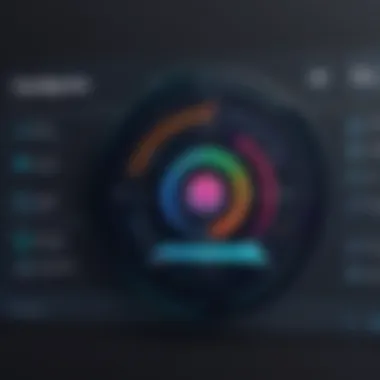Toggl vs ClickUp: Which Task Management Tool Wins?


Intro
In today's fast-paced business environment, effective task management and time tracking are crucial for professionals across various industries. As projects become more complex, tools such as Toggl and ClickUp have emerged, helping teams optimize productivity and monitor progress. Each platform offers distinct functionalities tailored to specific operational needs, making it essential for users to discern which software aligns better with their goals. This analysis aims to illuminate the key differences and similarities between Toggl and ClickUp, guiding decision-makers in their software selection process.
Key Features and Functionalities
Comprehensive Overview
Toggl is renowned for its intuitive time tracking capabilities. It allows users to record their hours effortlessly, break down tasks, and generate insightful reports. Features like one-click tracking and project tagging simplify the time management process, making Toggl suitable for freelancers and small teams.
On the other hand, ClickUp is a robust task management tool that integrates various functionalities into one platform. Its features range from task assignment to goal tracking. Users can customize workflows, set priorities, and utilize built-in docs and chats, positioning ClickUp as a versatile solution for larger teams and organizations.
Target Users
Toggl primarily targets freelancers, consultants, and small teams that prioritize effective time tracking. Users appreciate its straightforward interface and ease of use, which enable them to focus on their work without being bogged down by unnecessary complexities.
Conversely, ClickUp attracts a broader user base, including project managers and larger enterprises. Its scalability and multitude of integrations cater to diverse needs within teams, allowing for detailed project management and collaboration.
Pricing Models and Cost Analysis
Breakdown of Pricing Tiers
Toggl offers a freemium model where basic time tracking features are accessible for free. For more advanced features, the Starter plan costs $10 per user per month, while the Premium plan is $20 per user per month. This tiered structure allows users to scale according to their requirements.
ClickUp also employs a freemium model. Its free version is robust, making it appealing for new users. The Unlimited plan starts at $5 per user per month, and the Business plan is priced at $12 per user per month, with additional features for larger teams.
Additional Costs to Consider
Both platforms may incur additional costs due to premium integrations. Toggl allows integration with apps like Trello and Asana, which could lead to extra expenses depending on the chosen tools. Similarly, ClickUp offers advanced features that may require upgraded plans, impacting budgets for larger organizations.
Overall, it is vital for potential users to analyze their needs carefully and consider the total cost of ownership when selecting the right software for task management.
Preamble to Task Management Software
Effective task management is essential in any organizational setting, whether it be a small startup or a large corporation. Software tools designed for this purpose have gained traction, offering professionals the ability to streamline their workflows and manage their time effectively. These applications can lead to enhanced productivity and the successful completion of project goals. Implementing a task management system allows teams to coordinate their efforts, prioritize tasks, and monitor progress, thereby creating a more structured working environment.
Importance of Effective Task Management
A thoughtfully created task management system can improve collaboration within teams. When team members clearly understand their responsibilities, overall efficiency increases. The software can help in assigning specific tasks to individuals, which in turn fosters accountability. Moreover, effective task management aids in resource allocation—ensuring that the right people are working on the right tasks at the right time. This clarity helps reduce overlaps and miscommunication, crucial factors that can lead to project delays and cost overruns.
Additionally, proper task management enhances motivation. When team members can see what they have accomplished and what lies ahead, the sense of progress can drive performance. Moreover, managers can identify bottlenecks in workflows early, allowing for timely intervention and adjustments. In today’s fast-paced business landscape, the importance of effective task management cannot be overstated.
Overview of Time Tracking Tools
Time tracking tools are an integral part of task management software. They provide organizations insights into how time is spent on various tasks. This data is vital for optimizing workflows and conducting performance reviews. Implementing time tracking can benefit businesses by promoting accountability and ensuring that employees are aware of their time expenditure.
Furthermore, time tracking supports project budgeting. By understanding how long tasks take, organizations can create more accurate estimates, which directly influences project fees. It leads to better financial management overall.
- Benefits of time tracking tools include:
- Increased visibility on task durations
- Enhanced project forecasting
- Improved team accountability
- Better identification of productive vs. unproductive activities
Overall, the integration of task management and time tracking tools creates a comprehensive system that aids in achieving business objectives efficiently. By comparing solutions like Toggl and ClickUp, organizations can identify which software aligns best with their needs, ensuring the most effective use of resources.
Toggl: A Focus on Time Tracking
Time tracking is an essential function in today's work environment, where efficiency and accountability are paramount. Toggl is designed to meet this need by providing a specialized solution for time management. Its primary focus on time tracking makes it a valuable tool for freelancers, small teams, and larger enterprises that require precision in task management. In this section, we will explore the core features, user experience, integration capabilities, and pricing options of Toggl to evaluate its effectiveness as a time-tracking solution.


Core Features of Toggl
Toggl offers several key features that enhance its usability in tracking time across various projects. Here are some of the most notable functions:
- Simple Time Tracking: Users can easily start and stop timers for tasks, ensuring accurate logging of time spent on activities.
- Manual Time Entry: In case the timer is not used, users can manually input time, allowing flexibility.
- Reporting Tools: Toggl provides robust reporting capabilities, enabling users to generate insights on how time is allocated across different tasks and projects.
- Project Organization: Users can categorize their time entries by projects, clients, or tags. This organization assists in analytics and billing.
- Team Management: For enterprises, Toggl supports team management features, allowing supervisors to oversee team productivity.
These features position Toggl as a strong contender in the arena of time tracking applications, particularly for those seeking simplicity and efficiency.
User Experience and Interface
Toggl’s user interface is built with user-friendliness in mind, facilitating an intuitive experience. The design is clean and minimalistic, reducing complexity for users across different skill levels. Key points about user experience include:
- Mobile and Web Compatibility: Toggl is available on both web and mobile platforms, providing accessibility for users.
- Quick Navigation: Users can easily navigate between projects, reports, and settings without encountering confusion.
- Customizable Dashboard: The option to customize the dashboard allows users to prioritize the information most relevant to them.
- Visual Reporting: Visual representations, such as pie charts and bar graphs, help users quickly interpret their time tracking data.
Overall, Toggl's design emphasizes ease of use, enabling users to focus on their tasks rather than on managing the tool itself.
Integration Capabilities
Integration is crucial for software that aims to function well within existing workflows. Toggl supports various integrations that enhance its functionality. Notable integrations include:
- Project Management Tools: Integrations with software like Trello, Asana, and Todoist allow users to begin tracking time directly from their task lists.
- Calendar Applications: Syncing with Google Calendar or Outlook can help ensure that time is allocated correctly based on scheduled activities.
- Billing Software: Toggl can connect with invoicing tools, assisting users in generating invoices based on tracked time.
These integrations make Toggl a versatile option for professionals looking to optimize their task management capabilities.
Pricing Tiers and Options
Toggl offers different pricing plans to accommodate various user needs. Having flexible pricing structures ensures accessibility for freelancers, small teams, and enterprises alike. Here’s a brief overview:
- Free Plan: Basic features ideal for individuals or small teams starting to manage their time effectively.
- Starter Plan: A moderate subscription that adds features like billable rates and project templates, cost-effectively aiding small businesses.
- Premium and Enterprise Plans: Comprehensive options that provide advanced reporting, team management, and priority support for larger organizations.
Toggl's pricing structure provides transparency, making it easy for users to select a plan that matches their specific requirements. With its range of features and flexible pricing, Toggl stands out as a focused, effective solution for time tracking.
ClickUp: Comprehensive Project Management
ClickUp is positioned as a powerful tool for project management, offering a wide array of functionalities that cater to diverse professional needs. Its versatility sets it apart from other tools, making it an attractive option for teams aiming to enhance productivity. The importance of ClickUp in the sphere of task management cannot be overstated. Its comprehensive features allow individuals and organizations to streamline operations, thus leading to improved efficiency.
Core Features of ClickUp
ClickUp brings together several essential features that streamline task management. One standout functionality is the ability to create detailed tasks with various attributes. Users can add due dates, priority levels, and assignees, enabling clarity in responsibilities and deadlines. The platform supports checklists within tasks, which is invaluable for team collaboration. Additionally, ClickUp provides time tracking features, allowing teams to monitor how long tasks take. This is crucial for evaluating productivity.
Other features include goals and objectives tracking, document storage, and automation capabilities that reduce repetitive tasks. These functionalities create an all-in-one environment, making it easy for users to plan, execute, and monitor projects without switching between multiple applications.
User Experience and Customization
The user experience of ClickUp has been regularly praised. The interface is intuitive, making it simpler for teams to adopt without extensive training. New users can navigate the layout with ease, accessing core functionalities from the dashboard.
Customization plays a key role in ClickUp's appeal. Users can tailor views and workflows to fit their preferences. For instance, whether one prefers a traditional list layout or a Kanban board, ClickUp accommodates both styles. Colors, tags, and even task statuses can be adjusted to match individual or team needs. This level of flexibility promotes personal engagement with the tool and encourages users to maximize its potential.
Integration Capabilities
In the modern workplace, integration capabilities are critical for software tools. ClickUp does not disappoint in this area. It seamlessly integrates with a variety of applications such as Slack, Google Drive, and Zapier, which enhances its functionality and relevance in diverse working environments. Users can connect ClickUp with other tools they already use, effectively creating a cohesive workflow that reduces friction. This capability allows teams to centralize their work activities in one platform.
Pricing Tiers and Options
When it comes to pricing, ClickUp offers several tiers to cater to different team sizes and budgets. The Free plan provides core functionalities, making it a viable option for small teams or startups beginning their project management journey. The Unlimited plan adds more features with a reasonable monthly fee, which is still accessible for many.
For teams that require advanced features like goal tracking or more significant storage space, ClickUp also offers a Business tier. Pricing is transparent, with no hidden charges, making it easier for decision-makers to evaluate costs effectively. This pricing structure supports various organizational needs, enabling users to gradually scale their use of the platform as their projects grow.


"ClickUp’s array of features presents a compelling case for professionals seeking an adaptable and scalable project management tool."
Comparing Toggl and ClickUp
When considering task management software, one critical step is the comparison of tools like Toggl and ClickUp. Understanding their distinct differences allows professionals to select the software that best aligns with their needs. The analysis of both platforms reveals specific features, costs, and user experiences that can significantly impact decision-making. Inherent to this comparison are the insights into how effectively each platform supports productivity, time management, and overall project execution.
Feature Set Comparison
Toggl primarily excels in time tracking and simple task management, offering key features that prioritize efficiency in tracking hours worked. It includes functionalities like one-click time tracking, project categorization, and reporting tools that help users gain insights into how their time is spent. On the other hand, ClickUp encompasses a broader range of project management functionalities. Features include task assignment, document sharing, goal setting, and even calendar integrations.
Key Features of Toggl:
- Time tracking
- Reporting and analytics
- Simple project categorization
Key Features of ClickUp:
- Comprehensive project management
- Task assignments and deadlines
- Document collaboration
Evaluating these feature sets helps organizations determine what they prioritize in their workflows. For users who need in-depth project management solutions, ClickUp may be preferable, whereas Toggl serves those who focus predominantly on time tracking.
Usability and Learning Curve
Usability is critical for adoption and ongoing use of task management tools. Toggl has been praised for its intuitive interface, allowing users to easily navigate its features. New users generally find that they can start tracking time within minutes of signup. In contrast, ClickUp, while extensive in features, can present a steeper learning curve. Users may require time to familiarize themselves with the varied functionalities and customization options available.
- Toggl:
- ClickUp:
- Easy to learn and use
- Quick setup process
- More complex interface
- Greater initial time investment needed for setup
The feedback from the user base often reflects these points, indicating that if speed and simplicity are primary concerns, Toggl could be more beneficial. However, for teams seeking a more integrated approach, the initial learning investment in ClickUp might be justified.
Integration Ecosystem
Integrations are another vital area when examining Toggl and ClickUp. Toggl supports integrations with various applications such as Trello, Asana, and Google Calendar. This functionality is particularly useful for teams looking to streamline their processes by connecting tools they already use.
ClickUp, however, takes integration a step further. It offers a robust ecosystem that connects with over 1,000 apps, allowing users to blend their project management experience with a variety of existing workflows. This extensive compatibility enhances organizational flexibility.
- Toggl integrations include:
- ClickUp integrations include:
- Asana
- Trello
- Slack
- Google Drive
- Zapier
- Jira
The integration capabilities of each platform will heavily influence how teams adapt them into their existing structures. Those needing a rich array of adaptable solutions may gravitate towards ClickUp for its diverse options.
Cost-Effectiveness Analysis
Cost is always a crucial factor for any organization choosing software. Toggl operates on a straightforward pricing model with a free tier and paid plans that grow based on the features desired. As of now, you can expect about $10 per user per month for its Pro plan. This model works well for freelancers and small teams.
ClickUp, encompassing a more extensive feature set, also offers various pricing tiers. Its free version is considerably generous, with premium plans starting around $5 per user per month. Given the range of features available at relatively low costs, ClickUp can represent significant value for larger teams.
User Feedback and Reviews
User feedback and reviews represent an essential part of any comprehensive analysis of software solutions. Such feedback offers valuable insights into the real-world experiences of users, which can illuminate various unseen aspects of the software. For decision-makers, IT professionals, and entrepreneurs, understanding user sentiments can highlight both strengths and weaknesses that may not be immediately apparent from functionality descriptions alone.
When considering Toggl and ClickUp, user feedback helps potential buyers gauge aspects like reliability, ease of use, and how effectively the software meets their specific needs. Reviews often touch on issues of customer support, intuitive design, and the practical implications of tool features, influencing customers' choices significantly. Moreover, identifying trends in user opinions can reveal common pitfalls, helping buyers to avoid costly mistakes.


User Experiences with Toggl
Toggl has garnered a variety of user experiences focused on its time tracking capabilities. Many users commend its simplicity and ease of use. Professionals who require precise time tracking find Toggl's interface straightforward. Its ability to quickly start and stop timers is often highlighted as a key benefit.
However, some users express frustration with its reporting features. While the basic reports are satisfactory, advanced users sometimes find the analysis tools lacking complexity. Additionally, comparing the time tracked across various projects can be cumbersome.
Positive feedback emphasizes Toggl's integrations with other platforms, which streamline workflows effectively. Users appreciate how it connects with tools like Asana and Trello, enabling efficient project management. The mobile app also receives praise, allowing users to track time on the go.
User Experiences with ClickUp
ClickUp users typically report a richer feature set compared to Toggl, particularly in project management dimensions. Many users highlight its ability to customize views and manage tasks in a highly flexible manner. The variety of features available can cater to diverse project needs, from simple task lists to complex project timelines.
However, this complexity can lead to a steep initial learning curve for new users. Some individuals have noted that the abundance of features may be overwhelming. Yet, as users acclimate, they often find great value in the tool’s versatility.
Customer support experiences vary. While many users report positive interactions, others feel that response times could be improved during peak periods. Overall, for those needing a software that offers a wide range of capabilities in project management and collaboration, ClickUp often represents a favorable choice but requires a sound understanding of its extensive functionalities.
Choosing the Right Tool for Your Needs
Choosing the right task management tool is crucial for ensuring the productivity and efficiency of any organization. Such tools can profoundly impact how teams coordinate their efforts, manage time, and track progress. The decision between Toggl and ClickUp necessitates careful consideration of specific elements such as company size, budget constraints, and unique operational needs. Both software have strengths that may cater better to different demographics. Understanding the nuances between them can lead to better alignment with organizational goals and smoother workflows.
When exploring Toggl and ClickUp, it is essential to focus on the features that truly matter for your specific context. For instance, the emphasis on time tracking in Toggl is beneficial for companies with invoicing or project-based work. In contrast, ClickUp's comprehensive tool set offers functionalities that support broader project management applications and collaboration. Therefore, evaluating these aspects can enhance decision-making and streamline processes for teams.
Considerations for Small Businesses
Small businesses often operate on tight budgets with limited resources. For them, choosing a tool that balances cost-effectiveness with essential features is important. Toggl may be an appealing option due to its straightforward interface and focus on time tracking. It enables smaller teams to manage projects efficiently without excessive complexity. In fact, the ability to generate reports within Toggl allows businesses to evaluate productivity effectively.
On the other hand, ClickUp presents an all-in-one solution that might be attractive for small businesses aiming for growth. The extensive customization options allow teams to tailor the software according to their unique workflows. This flexibility caters to the evolving needs of a small business as it grows. However, the initial learning curve might be steeper, requiring some investment in time before fully reaping the benefits.
Key factors for small businesses to consider:
- Budget: Ensure the chosen software fits within financial constraints.
- Ease of use: A simpler interface may reduce the learning time.
- Scalability: Opt for a tool that can grow with the business's needs.
- Customer support: Adequate assistance can ease transitions and resolve any issues quickly.
Considerations for Enterprises
For enterprises, the stakes are higher, and the decision-making process becomes more involved. Larger organizations typically require more robust functionalities, advanced integration options, and comprehensive reporting capabilities. ClickUp, with its myriad of features, is likely to meet these demands effectively. Its project management capabilities can support multiple teams and offer extensive customization that resonates with diverse enterprise needs.
Moreover, integration with other enterprise systems is often essential, ensuring seamless operation across different departments. This interoperability is one of ClickUp's strong points, allowing teams to utilize their preferred tools without friction.
Toggl also serves enterprises well, particularly for those that prioritize time tracking and resource allocation. Enterprises functioning on billable hours can leverage Toggl's reporting features, making it easier to ensure projects are profitable.
Key factors for enterprises to consider:
- Integration capabilities: Ensure compatibility with existing software and tools.
- Feature set: Assess whether the software meets complex project needs and reporting requirements.
- User management: Look for options that allow ease of addition and management of users.
- Compliance and security: Larger organizations often have stricter compliance requirements that must be ensured.
End
In this article, we explored the distinct features and characteristics of Toggl and ClickUp, two leading software solutions in the realm of task management and time tracking. The analysis targets not just the functionalities but also the nuances that can affect user experience and overall satisfaction.
Importance of the End
The conclusion provides a critical synthesis of the information presented. It reaffirms the significance of choosing the right tool that aligns with individual or organizational needs. It is not merely about capabilities but rather about fit within specific operational contexts.
Choosing a software solution involves understanding its adaptability to your workflow, the cost associated with the tool, and how well it integrates with other systems in use. Hence, the choice between Toggl and ClickUp should be informed by clear priorities.
Key Considerations
- Functionality: Each software offers a unique set of tools. Toggl shines in time tracking, ideal for those focusing primarily on that aspect. ClickUp, with its extensive project management features, suits teams needing a comprehensive solution.
- User Experience: The user interface can significantly impact productivity. Toggl provides a simple, user-friendly experience for time tracking, while ClickUp’s customizable options appeal to diverse project requirements.
- Cost-Effectiveness: Evaluating the pricing against provided features is essential. Organizations must assess potential ROI based on their specific tasks to make informed decisions.
Final Thoughts on Toggl and ClickUp
The decision should be more than a simple feature comparison. It requires deep consideration of how each tool fits within your workflow and contributes to achieving your goals. As the landscape of task management continues to evolve, remaining informed and adaptable will enable professionals and businesses to optimize their operations effectively.
"The right software choice can enhance productivity and align operations with broader business objectives."
Ultimately, understanding one's needs and how each platform can meet those needs is vital. Making an informed decision can be a catalyst for improved efficiency and effectiveness in task management.















